At the end of World War 2, some 120,000
Polish servicemen and women who had fought alongside the allies, accepted
the British Government’s offer to settle in this country. They decided to
stay in Britain rather than go back to their homeland because Poland had
fallen under the totalitarian communist regime of Stalin’s Soviet Union.
Because of the housing shortage which had been created by the war, the
Poles were housed in various temporary camps around the country. Most of
these camps had been constructed during the war to fulfil various
functions including providing accommodation for troops, and even hold
prisoners of war. There were a number of such camps in south
Buckinghamshire, including one at Hodgemoor Wood, which was just off the
A355, between Amersham and Beaconsfield, near Coleshill. Bottrells Lane
ran right through the centre of the camp during its existence.

Picture courtesy www.polishresettlementcampsintheuk.co.uk
Inside the Nissen hut
which served as a Community Hall. A meeting is taking place
Wherever possible the Poles were housed alongside their wartime comrades
and Hodgemoor Camp was occupied mainly by ex-servicemen who had fought
with the 3rd Carpathian Rifle Division, and their families. Amersham
residents therefore can be proud of the fact that their local Polish Camp
was settled by men who had belonged to a unit which played a major role in
several famous battles of the Italian Campaign. Monte Cassino was captured
by the 3rd Carpathians.
The first Poles began to move into Hodgemoor in 1946 and the camp’s
prefabricated buildings and Nissen huts soon began to take the form of a
Polish village. There were 180 dwellings some of which were sub-divided
into smaller units, and in all, the population of Hodgemoor Camp reached
approximately 600 at its peak during the 1950’s.
 Picture courtesy Henry Wigier
Picture courtesy Henry Wigier
Outside the Church
Apart from the dwellings the camp had, right in its midst both socially
and physically, four Nissen huts which served various needs of the
community. The most prominent of these was the church which was run by a
priest Father Josef Madeja, who lived in the camp and performed mass there
every day. In fact on Sundays there were three masses, two in the morning
and one in the evening. The other three Nissan huts served as a community
hall for parties, dances and plays, a weekend school for children, a
library of Polish books, and a pub. The pious Catholic Poles are also
renowned for enjoying the odd glass of vodka or beer.
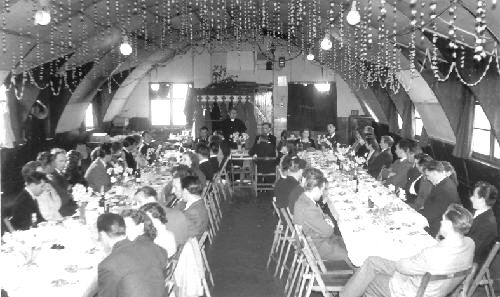
Picture courtesy www.polishresettlementcampsintheuk.co.uk
A Christmas party
The Poles were very industrious and most of them, both men and women,
worked in the nearby large towns, mainly Slough and High Wycombe. Many
Poles from Hodgemoor worked at the Mars factory in Slough which was
renowned for its high wages and excellent conditions. Consequently many
families were able to afford cars or motorbikes and so commuting from this
isolated place did not present a great problem.
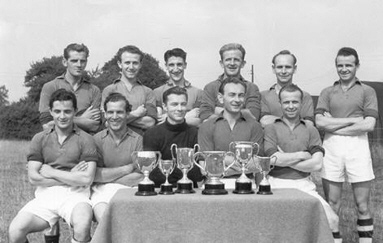
Picture courtesy www.polishresettlementcampsintheuk.co.uk
Hodgemoor had its own
football team – called Junak.
Most Hodgemoor children attended nearby Chalfont St Giles infants and
middle school, which was a bit far to walk to. So as there was no bus
service, some of the car-owners who had finished their night shifts at
work, would run them to school in the morning. They would then bring them
back in late afternoon, after they’d had some sleep.
As the housing shortage throughout the UK began to ease by the late 1950’s
and the camp was earmarked for demolition, the Poles began to move out.
Many, particularly those who worked in Slough and could afford it, bought
houses there. Slough had a large Polish community long before 2004 when
Poland joined the EU and many of its nationals came to work there. Other
Poles chose to live in nearby Amersham and quite a few settled in Great
Missenden.
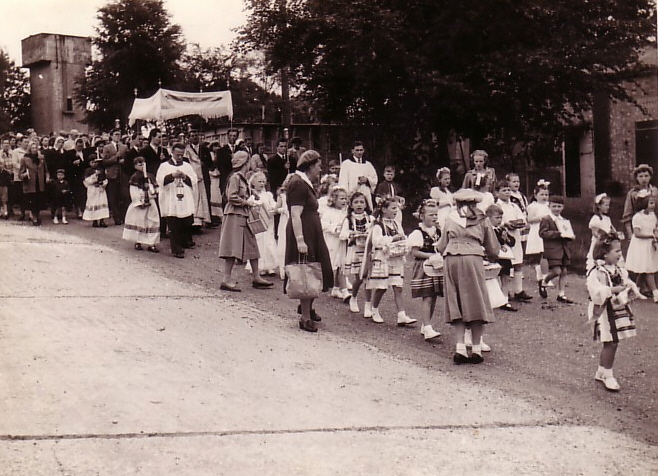 Picture courtesy Henry Wigier
Picture courtesy Henry Wigier
An Easter parade wends its
way down Bottrells Lane
Today, Hodgemoor Wood is a recreation park but there is a plaque to
commemorate its time when it was literally ‘a Polish village in the
English countryside’. However, this plaque does not mark the end of the
Polish Community in the Amersham area. Whereas in some cases
multi-cultural Britain seems to have problems with assimilating some of
its ethnic minorities – with the Poles it was the opposite. Many of the
older generation were worried that the youngsters were assimilating too
quickly, thereby abandoning their roots. So in the late 1970’s a group of
ex-Hodgemoor Poles decided to build some sort of central community place
in Amersham to carry on Polish traditions and culture.
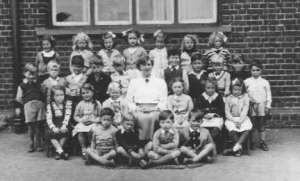 Picture courtesy Henry Wigier
Picture courtesy Henry Wigier
Chalfont
St Giles Infants
School 1953
Many of these children are
Poles from Hodgemoor
With help from Amersham Town Council and Buckinghamshire Education
Authority who owned Raans Road Secondary Modern School, they were able to
build a Polish Club within a corner of the school’s spacious grounds. The
school itself no longer exists but the thriving Polish Club, officially
re-named The Bor-Komorowski Club after a Polish World War 2 hero, still
stands at the end of Raans Road in Amersham On The Hill.
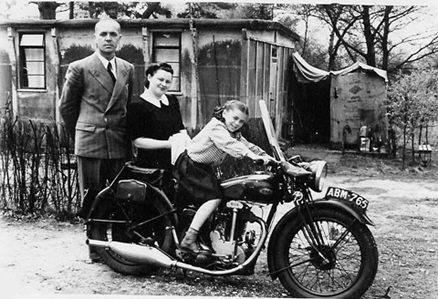 Picture courtesy Marie
Bożena Gaffney
Many Hodgemoor residents
owned cars or motorbikes.
Picture courtesy Marie
Bożena Gaffney
Many Hodgemoor residents
owned cars or motorbikes.







